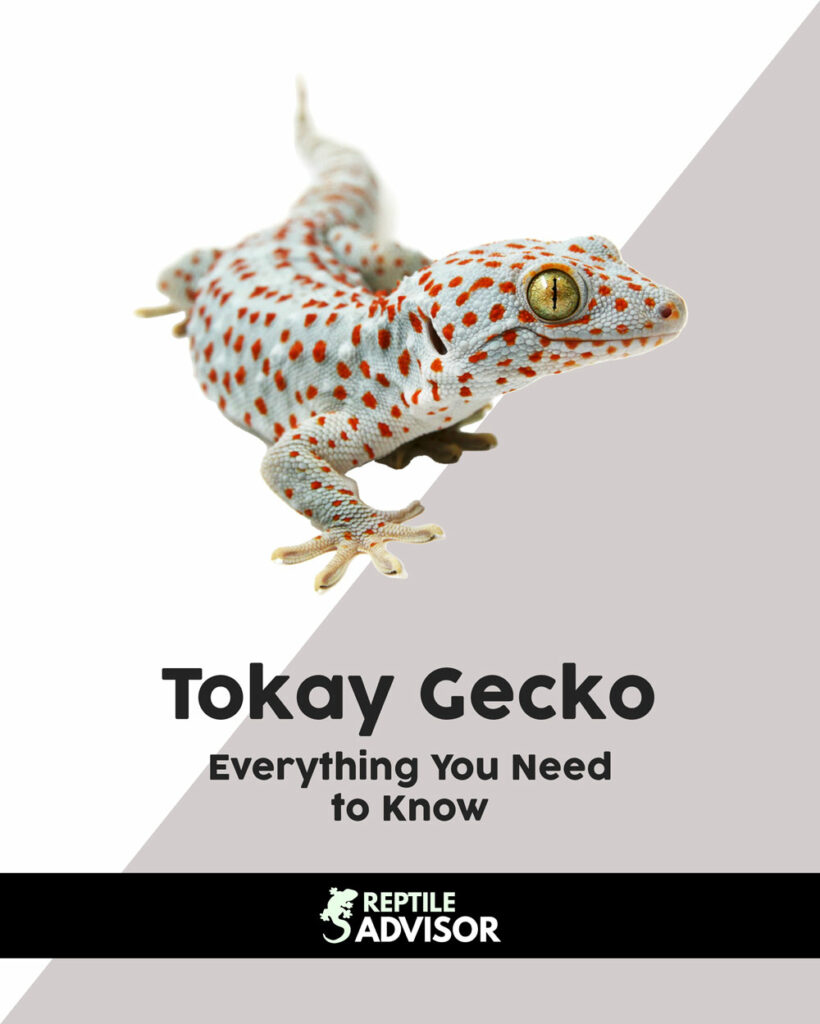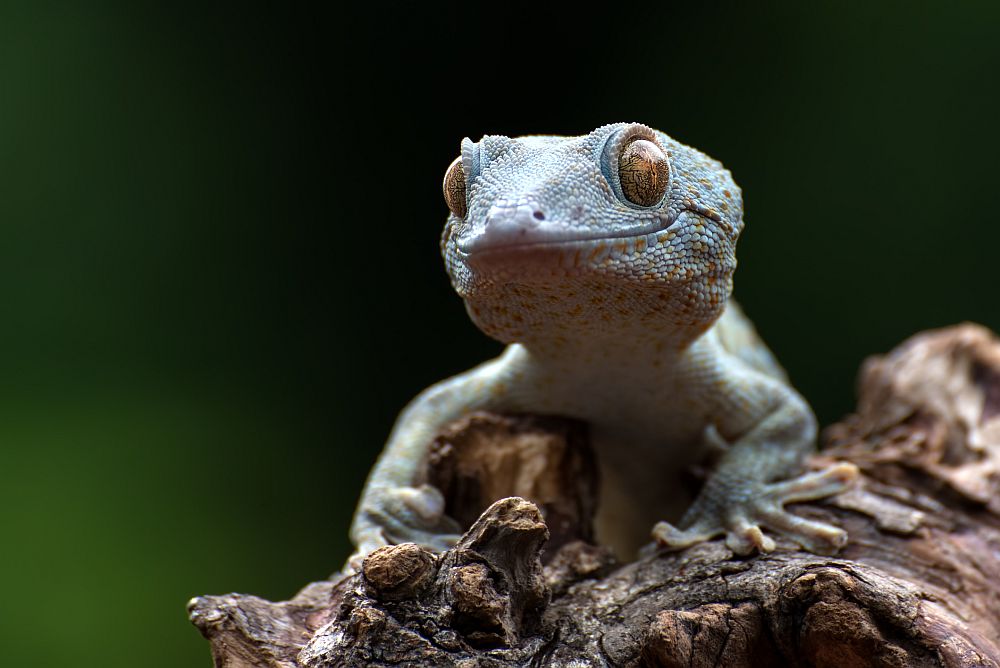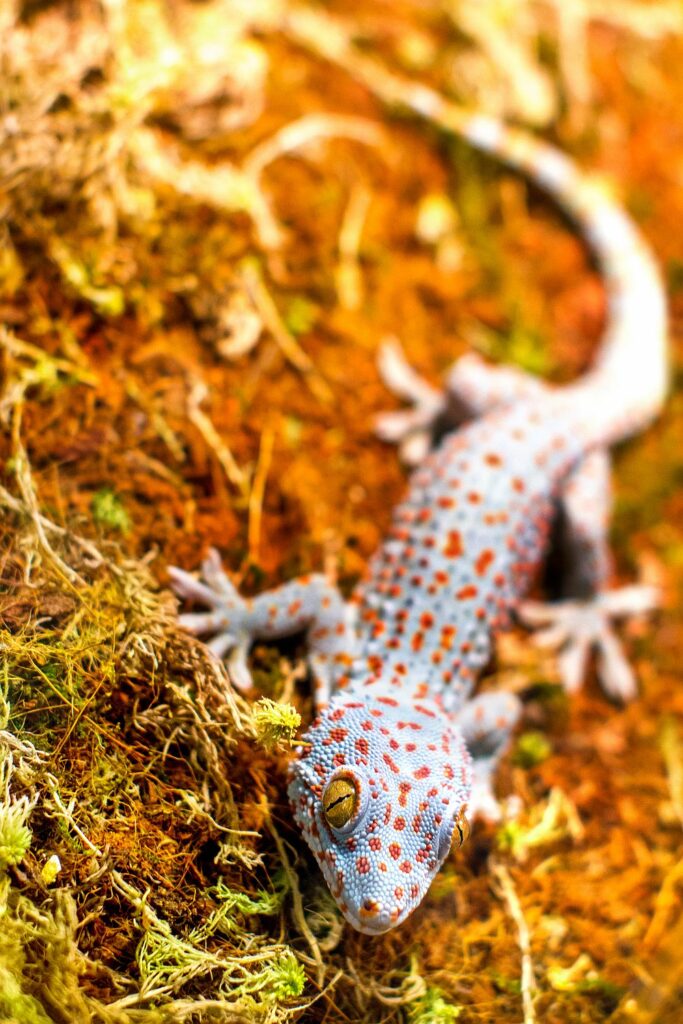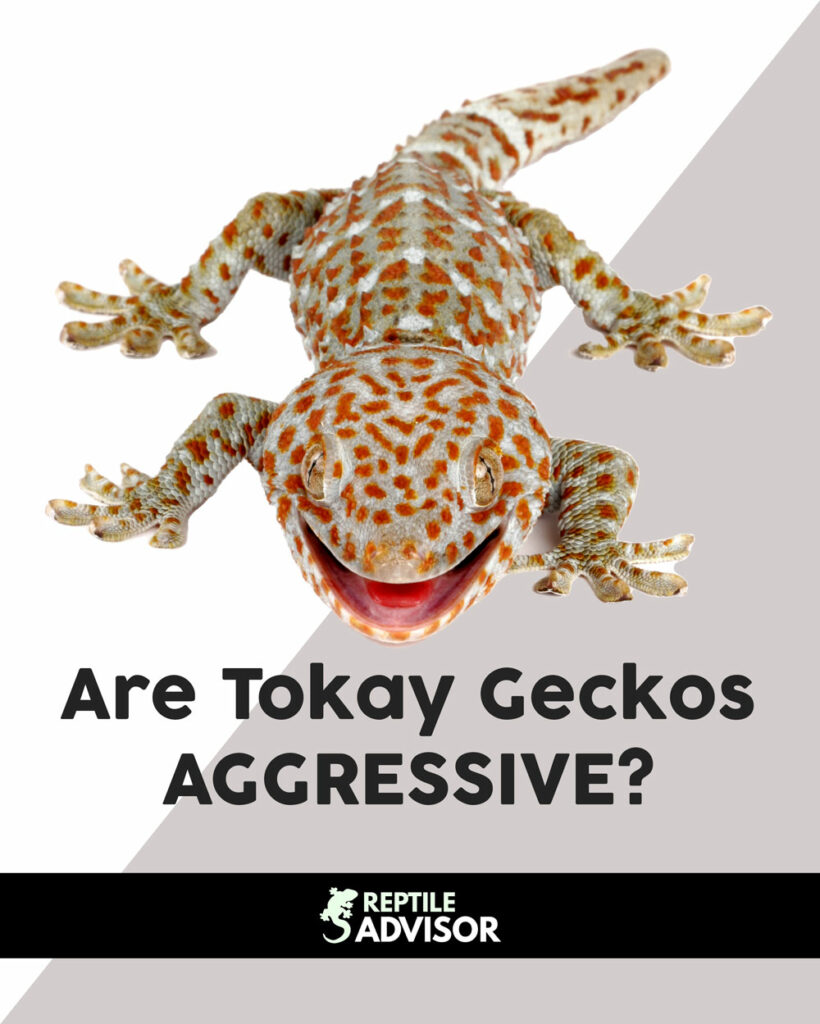Tokay Geckos are beautiful, inexpensive, and easy to take care of. They are also cage-defensive, hate handling, and are not afraid to bite.
So if you have some experience with nippy lizards or snakes, and you can meet the Tokay Gecko’s modest food and habitat needs, your lizard may become a showpiece of your herp collection.

Curious to know more? This article will teach you everything you need to know about Tokay Gecko care.
Quick Navigation
Do Tokay Geckos Make Good Pets?
For the most part, Tokay Gecko care is no more difficult than caring for Leopard Geckos. While the Tokay needs a bit more heat, humidity, and climbing space, it will tolerate less than ideal conditions even if it doesn’t thrive in them.
The problem does not lie with Tokay Gecko care requirements, but with the Tokay Gecko bite.

Tokay Geckos are cage-defensive. When you stick your hand in their home to remove them, Tokays react like you are a predator. Those needle-sharp little teeth and surprisingly powerful jaws can draw blood. And when you pull back, the Tokay bites even harder. An angry Tokay can hang by its teeth like a tiny lizard pit bull.
Once they let go of your now-bleeding flesh, the Tokay Gecko will try to escape. Because they are larger than Leopard Geckos, Tokays can move more quickly. And unlike Leopards, Tokays have pads on their feet that allow them to climb walls. If your Tokay breaks free, it may very well climb up your wall and run behind a bookcase or into an air vent.
For those reasons, Tokay Geckos are best suited to keepers who have experience with nippy reptiles or who are not afraid of getting bitten by a foul-tempered lizard. You will also need to take more efforts to keep the area around your Tokay Gecko’s habitat as clear as possible to avoid nerve-wracking escapes.
| SPECIES OVERVIEW | |
| Scientific name | Gekko gecko |
| Common name | Tokay Gecko |
| Family | Gekkonidae |
| Size | 10-16 inches (25-40 cm) |
| Life expectancy | 10-20 years in captivity |
| Tank size | 30-gallon |
| Humidity | 60-80% |
| Temperature | 80-87°F (26-30°C) |
| Diet | Crickets, mealworms, and cockroaches |
Tokay Gecko Housing Requirements
Whatever enclosure you choose, your first priority should be to make sure the top is secured. Tokay Geckos are notorious escape artists who can climb up the glass sides of their home.
You will also need to make sure your Tokay Gecko habitat gets a period of darkness. Tokay Geckos are nocturnal and come out at night. A room where the lights are always on will cause your animal undue stress.
Tokay Gecko Enclosure (Cage Size)
A 30-gallon tank is an ideal size for a Tokay Gecko enclosure. You will need at least one climbing branch for your habitat, as Tokay Geckos like to climb. You will also need at least one and preferably more hides since Tokay Geckos like to stay sheltered from predators.
Because Tokay Geckos are territorial and solitary animals, your Tokay Gecko will require its own habitat, otherwise they will fight amongst themselves and squabble with any other reptile you put them in with.
Substrate

Newspaper is easy to clean, but not particularly aesthetic. If you want to put some plants in your Tokay Gecko habitat, ZooMed’s ReptiSoil is an excellent choice as it will both promote rooting and hold much-needed humidity.
Whatever substrate you choose, make sure you keep it clean. Mold, bacteria, and other organisms can grow in a dirty Tokay Gecko habitat, leading to skin and respiratory infections.
If you are using local soil, driftwood or branches, put them in your oven at the lowest heat setting for several hours to kill any mites or parasites that might hitch a ride into your Tokay Gecko’s enclosure.
Heating
Because Tokays are nocturnal, you may want to avoid the bright UVA heat lamps frequently used for sun-loving lizards like bearded dragons. Undertank heating or ceramic heaters will be better for providing your Tokay Gecko with a basking spot.
Tokays do best in temperatures of around 80℉-87℉. Your Tokay Gecko habitat should have a thermometer probe to ensure temperatures stay in that range. While Tokays can tolerate brief periods of higher or lower temperatures, they will do better if you avoid extremes in either direction.
Because a properly heated enclosure is so important to your Tokay Gecko’s health, you really shouldn’t guess at the temperatures. A quality temperature gauge and a rheostat and timer can ensure your Tokay Gecko enclosure stays at the proper temperature.
Lighting
Tokay Geckos do not need UVB light to metabolize calcium. In fact, Tokays don’t need any artificial light at all. If your herp room has a window they should get enough sunlight to keep their circadian rhythms working.
As with most nocturnal animals, it’s more important to make sure your Tokay Gecko habitat gets enough darkness. You will see more activity after sunset if you keep the room dimly lit. Tokay Geckos are found in many southeast Asian cities and will not be traumatized by light in the room so long as they get a time of darkness.
Humidity
Your Tokay Gecko enclosure humidity should be kept between 60% to 80%. The best way to achieve this is to mist your tank in the evening. After you do this, quickly wipe down the glass walls of your Tokay Gecko habitat so your Gecko can climb on them.
You should also make sure your Tokay Gecko always has an available bowl of fresh, clean water. Check the water regularly, as your Tokay Gecko will use it both as a drinking fountain and a toilet.
Feeding A Tokay Gecko
In the wild, the Tokay Gecko diet consists mostly of whatever they can get hold of. Their diet mostly consists of insects like moths, grasshoppers, crickets, and beetles. (They developed that strong bite largely to crunch through the exoskeletons of big tropical beetles). But they will eat smaller reptiles, snakes, and mice if they get a chance.

The Tokay Gecko is primarily an ambush predator. They sit motionless until the food comes within range, then attack with lightning speed and a fast bite. Since insects are plentiful in the tropical and semitropical regions the Tokay Gecko calls home, they have no trouble finding enough to eat.
In captivity, you should feed your Tokay Gecko several insects every day. Crickets, cockroaches, beetles, mealworms, or grubs will do. Tokay Geckos are not picky eaters. Make sure to dust their insects with calcium powder and a vitamin D3 supplement to keep their bones strong and prevent metabolic bone disease.
Common Tokay Gecko Health Issues
While Tokay Geckos are generally sturdy lizards, there are a few health problems that a Tokay Gecko owner needs to watch out for.
Poor Shedding
If you don’t keep the humidity high enough in your Tokay Gecko habitat, your gecko may have trouble shedding. Signs of shedding trouble include sheets and flakes of shed clinging to head, tail and limbs. Pay especially close attention to your Tokay’s toes, tail tip, and eyes, as stuck shed in those areas could cause constrictive damage or other complications.
Your Tokay isn’t going to enjoy a vigorous rubdown with a soft moist towel, but you might be able to get away with misting the area with warm water and peeling off the stuck areas. (Garden gloves help soften the blow if your Tokay Gecko proves uncooperative).
If all else fails, you can place your Tokay in a container lined with warm, moist paper towels and put a lid on for up to 10 minutes to moisten and loosen the shed. If all else fails, you may need to take your Tokay to a vet.
Parasites
Most Tokay Geckos in the pet trade are wild-caught animals, many of whom arrive with intestinal worms, and other parasites. If your Tokay Gecko has a bloated belly, is losing weight, refusing food, or leaving smelly and runny bowel movements, there is a good chance it is infested with parasites.
While you can find anti-parasitic medications online, you really should consult a veterinarian who can determine precisely what is troubling your Tokay Gecko and provide an appropriate dosage of a properly targeted medication.
You will need to clean your Tokay Gecko enclosure thoroughly after a parasite problem to prevent reinfestation. You should also make sure that any new reptiles you bring into your collection are quarantined safely away from your other herps until you are certain they carry no parasites or contagious diseases.
Mites
Mites are tiny eight-legged organisms that prey on reptiles the way lice prey on humans. The presence of mites in a Tokay Gecko enclosure can result in significant blood loss and skin irritation, and mites can also transmit diseases from one reptile to another.
If your Tokay Gecko is spending a great deal of time soaking in its water dish, or you see a white dust at the bottom of your Tokay Gecko habitat, you may have mites. You can often see mites by closely inspecting your Tokay Gecko’s eye area and cloaca.
Put any mite-infected Tokay Gecko in a plastic container with paper substrate and as few hides or other furniture as possible. Thoroughly clean the mite-infested Tokay Gecko enclosure and spray it with an anti-mite spray. If you have a mite infestation throughout your entire herp area, you may need to consult pest control professionals.
Metabolic Bone Disease (MBD)
Your Tokay Gecko’s diet must be supplemented with calcium and D3. There are a number of supplements you can add to your Tokay Gecko’s insects that will help ensure its bones stay strong, dense, and healthy. Lacking those supplements, your Tokay Gecko may fall prey to Metabolic Bone Disease (MBD).
Tokay Geckos that do not receive proper supplementation will seem fine at first. But as their bones grow more rubbery the gecko’s limbs become bowed and their tails kinked. As the process continues the jaw may become rubbery, making it impossible for your gecko to eat.
You may be able to reverse a mild case of MBD by increasing your Tokay Gecko’s calcium and vitamin D intake. A veterinarian may be able to treat severe MBD with liquid calcium or calcium injections. Generally these treatments will prevent further damage, but will not correct any bone deformities that have already taken place.
Are Tokay Geckos Aggressive?
Tokay Geckos are certainly aggressive toward each other. If you put two Tokay Geckos in a tank, the stronger will severely injure or even kill the weaker one.

The Tokay Gecko’s attitude toward its keepers is more accurately described as defensive. Your Tokay Gecko bites not because it wants to show dominance over you, but because it wants to be left alone.
This may not make you feel better about the foot-long lizard hanging off your hand, but it will help you better understand why your Tokay Gecko bites. Do what you can to keep your Tokay Gecko calm and you will both be happier.
Where to Buy a Tokay Gecko
While you may find Tokay Geckos in chain pet stores, your best bet is to buy your Tokay Gecko from a reputable breeder. Most of the Tokay Geckos in the pet trade are wild-caught and are likely to arrive in your house with a host of parasites and diseases.
A captive-bred Tokay Gecko is still likely to be snappy, but it will be more acclimated to human contact than a wild Tokay Gecko rudely plucked from his home and shipped across an ocean in a cargo hold. And dedicated Tokay Gecko breeders have even proven out several beautiful new Tokay Gecko morphs.
Tokay Gecko Morphs
While the wild-type Tokay Gecko is a beautiful animal, Tokay Gecko breeders have proven a number of Tokay Gecko morphs that have become popular with Tokay Gecko keepers.
Calico
Calico Tokay Geckos have white patches breaking up their regular pattern and background, like the “Piebald” mutation found in horses, dogs, and snakes. A high-calico Tokay Gecko morph can be almost entirely solid white save for a few black specks.
Granite
The Granite Tokay Gecko Morph removes red pigment, leaving behind a powder blue-grey Tokay Gecko with black, spotted patterns that resemble the grain of granite. Blue Granites are more noticeably blue, while Blue and Yellow Granites have spots and patches of yellow.
High Red
High Red Tokay Geckos (also called “Super Red”) have elevated production of red pigment. The expression of this Tokay Gecko morph can produce anything from bigger red spots to a solid red Tokay Gecko.
Leucistic
The Leucistic Tokay Gecko morph results in a solid white Tokay Gecko with sapphire blue eyes. High white Calico Tokay Geckos with black eyes have been sold as “leucistic” but true leucism involves a complete absence of melanin.
Melanistic
The Melanistic Tokay Gecko morph increases the amount of black pigment produced. The melanistic morph can produce anything from a gecko that looks like a “fired up” normal type darkened by stress to a dark charcoal-grey.
Patternless
The Patternless Tokay Gecko morph is also called “Powder Blue.” The spots and patterns on a wild-type Tokay Gecko are suppressed, leaving only the sky-blue background color. Patternless Tokay Geckos will frequently also have a green head.
Tokay Gecko (Gekko gecko) FAQ
Do Tokay Geckos need heat lamps?
While a Tokay Gecko habitat needs supplemental heating and a basking spot, heat lamps are not the best choice. Tokay Geckos are nocturnal and the additional light from a heat lamp can interrupt their circadian rhythm. Use a ceramic overtank heater or undertank heating instead.
Is a Tokay Gecko poisonous?
While a Tokay Gecko’s bite is painful, Tokay Geckos have no venom glands and cannot inject venom like a Gila Monster or Mexican Beaded Lizard. But Tokay Geckos can carry bacteria like E. coli that can cause serious health problems. Wash before and after handling your Tokay and clean every Tokay Gecko bite thoroughly.
What eats a Tokay Gecko?
Tokay Geckos are nippy because in their native habitat many animals see them as a tasty snack. From the moment they hatch Tokay Geckos are preyed upon by snakes, frogs, and birds, and adult Tokays are eaten by cobras, kraits, and raptors.
Do Tokay Geckos like to be handled?
Tokay Geckos dislike handling and will often bite the hand that touches them. With time your pet may come to tolerate your presence in their Tokay Gecko habitat, but most Tokay Geckos remain nippy their entire lives.
Are Tokay Geckos endangered?
While Tokay Geckos remain common, their numbers have declined as much as 50% throughout much of their range. Many Tokay Geckos are captured each year for the pet trade and for use in Traditional Chinese Medicine.
What does a Tokay Gecko eat in the wild?
According to the Smithsonian National Zoo, the Tokay Gecko’s diet primarily consists of invertebrates like moths, locusts, beetles, cockroaches, termites, crickets, and mosquitos. But if a small rat, mouse, or snake walks within ambush range, a Tokay Gecko will happily eat it.
What noise do Tokay Geckos make?
Tokay Gecko males make a loud croaking noise which gives them their name. In Java this sound is written as Tou-Kay, in Thailand Tuck-Tou, and in the Philippines Tuko. During the Vietnam War U.S. soldiers nicknamed the Tokay the “F___ You Lizard.”
Can Tokay Geckos be tamed?
Most Tokay Geckos available in the pet trade are wild-caught specimens that will remain defensive and nippy their entire lives. Captive-bred Tokay Geckos may be more tolerant of human interaction, but most keepers get a Tokay Gecko bite at least occasionally.
Should I turn my Tokay Gecko’s light off at night?
Tokay Geckos are nocturnal, sheltering by day and going out by night. If you leave a Tokay Gecko habitat lights on (or leave room lights on without covering the cage), you will disturb your Tokay Gecko’s circadian rhythms. This can lead to feeding issues and failure to thrive.
What role do Tokay Geckos play in the ecosystem?
Tokay Geckos eat many insects, including pests like mosquitos and cockroaches that can spread diseases. Tokay Geckos are also an important food source for many snakes and birds that also eat rats, mice, and other vermin.
Conclusion
They are spunky lizards that will sink their teeth into you at any opportunity, but there’s still something lovable about these big, beautiful geckos with their stunning spots and space-alien heads. If you can tolerate an occasional Tokay Gecko bite and meet rudimentary Tokay Gecko habitat requirements, you will find Tokay Gecko care to be easy.